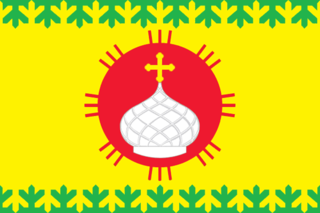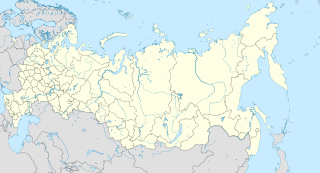| Mezhdurechensk Междуреченск(Russian) Междуреченск (Komi) | |
|---|---|
| - Urban-type settlement [1] - | |
 Location of the Komi Republic in Russia | |
| Administrative status (as of December 2014) | |
| Country | Russia |
| Federal subject | Komi Republic [1] |
| Administrative district | Udorsky District [1] |
| Urban-type settlement administrative territory | Mezhdurechensk Urban-Type Settlement Administrative Territory [1] |
| Administrative center of | Mezhdurechensk Urban-Type Settlement Administrative Territory [1] |
| Municipal status (as of December 2014) | |
| Municipal district | Udorsky Municipal District [2] |
| Urban settlement | Mezhdurechensk Urban Settlement [2] |
| Administrative center of | Mezhdurechensk Urban Settlement [2] |
| Statistics | |
| Population (2010 Census) | 1,418 inhabitants [3] |
| Time zone | MSK (UTC+03:00) [4] |
| Postal code(s) [5] | 169260 |
| 2010 Census | 1,418 [3] |
|---|---|
| 2002 Census | 1,951 [6] |
| 1989 Census | 3,273 [7] |
| 1979 Census | 3,030 [8] |
Mezhdurechensk (Russian : Междуре́ченск; Komi : Междуреченск) is an urban locality (an urban-type settlement) in Udorsky District of the Komi Republic, Russia. As of the 2010 Census, its population was 1,418. [3]

Russian is an East Slavic language, which is official in the Russian Federation, Belarus, Kazakhstan and Kyrgyzstan, as well as being widely used throughout Eastern Europe, the Baltic states, the Caucasus and Central Asia. It was the de facto language of the Soviet Union until its dissolution on 25 December 1991. Although nearly three decades have passed since the breakup of the Soviet Union, Russian is used in official capacity or in public life in all the post-Soviet nation-states, as well as in Israel and Mongolia.
The Komi language is a Uralic macrolanguage spoken by the Komi peoples in the northeastern European part of Russia. Komi may be considered a single language with several dialects, or a group of closely related languages, making up one of the two branches of the Permic branch of the family. The other Permic language is Udmurt, to which Komi is closely related.
The classification system of the types of inhabited localities in Russia, the former Soviet Union, and some other post-Soviet states has certain peculiarities compared with the classification systems in other countries.









